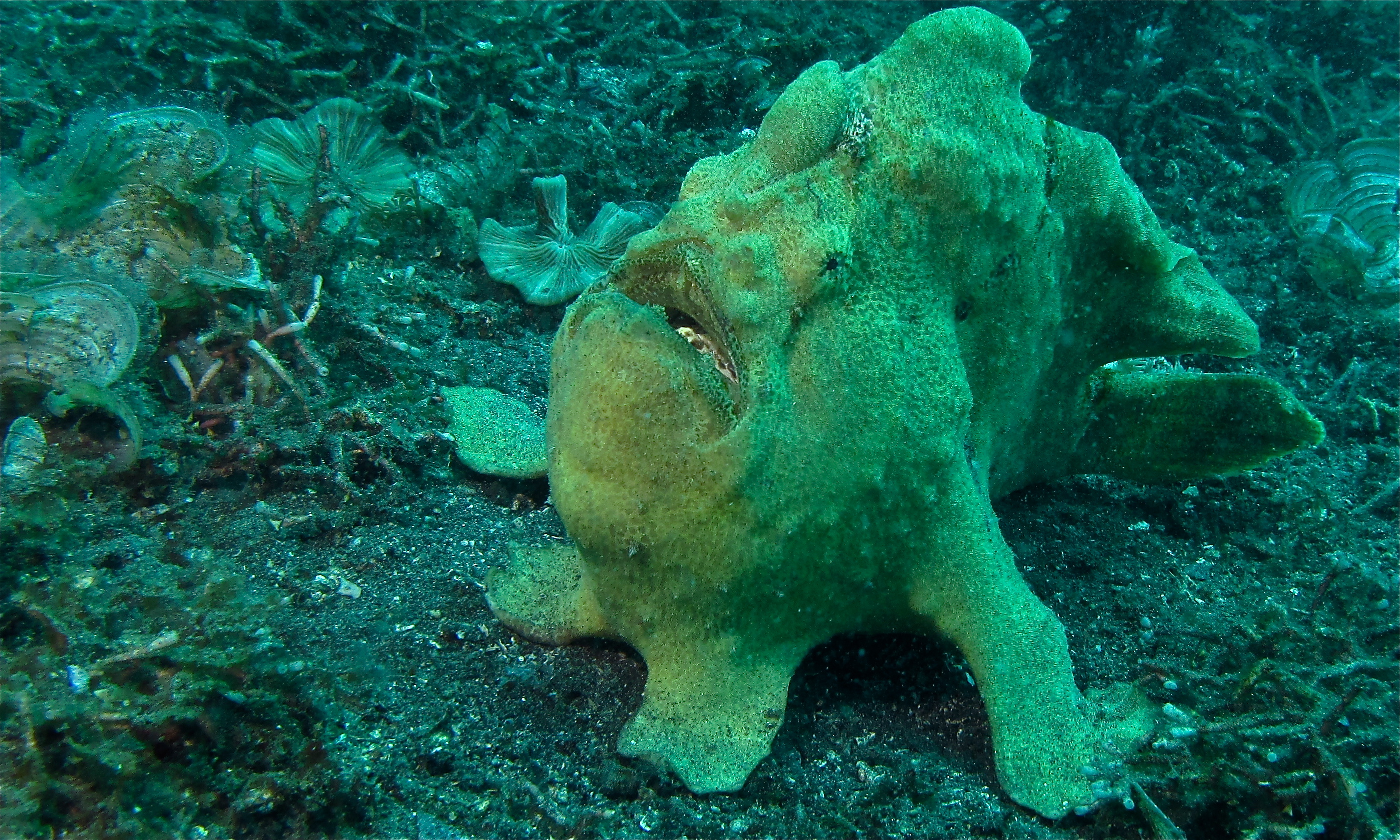Despite the remarkable variability in coloration, the dominant hue of the giant frogfish typically transitions from gray to black, encompassing a spectrum of related colors such as cream, pink, yellow, red, and brown. Additionally, these frogfish often display round eyes or spots that are noticeably darker or thicker than the surrounding background, further aiding in their camouflage. However, this extensive color variability can sometimes lead to confusion, particularly among adolescent specimens, which closely resemble related species like Antennarius maculatus and Antennarius pictus.
Giant Frogfish: Profile, Traits, Facts, Ecology, Range, Size, Diet
Commerson’s frogfish, also known as the giant frogfish, possesses an extraordinary ability to change its coloration to blend seamlessly with its surroundings. This remarkable adaptation allows it to camouflage itself effectively, making it a highly efficient predator in its marine habitat. The process of color change is a complex one, involving specialized cells called chromatophores that expand or contract to produce different hues and patterns. These intricate color changes enable the frogfish to mimic various elements of its environment, such as coral reefs, sandy seabeds, or even other marine creatures. By blending in with its surroundings, the frogfish can ambush unsuspecting prey with remarkable precision.
The Unique Locomotion Techniques of Commerson’s Frogfish
In addition to its camouflage abilities, Commerson’s frogfish utilizes its pelvic fins, often referred to as “wings,” in a remarkable manner. These fins are modified to serve as sturdy limbs, allowing the frogfish to walk along the ocean floor with surprising agility. This unique form of locomotion enables the frogfish to navigate complex terrain and maintain a steady position while lying in wait for its prey. By using its pelvic fins to anchor itself to the substrate, the frogfish can execute lightning-fast strikes against passing prey with remarkable accuracy. This combination of stealthy camouflage and specialized locomotion makes Commerson’s frogfish a formidable predator in its underwater realm.
Taxonomic Classification and Habitat of Commerson’s Frogfish
Scientifically known as Antennarius commerson, Commerson’s frogfish belongs to the family Antennariidae, a group of marine fishes commonly referred to as frogfishes due to their frog-like appearance and behavior. These fascinating creatures are primarily found in tropical and subtropical waters, inhabiting coral reefs, rocky outcrops, and sandy bottoms. Their distribution spans various oceanic regions, including the Indo-Pacific, Atlantic, and Indian Ocean. Commerson’s frogfish is well adapted to its benthic habitat, where it relies on its remarkable camouflage and unique locomotion techniques to thrive amidst the diverse marine life found in these ecosystems.
Distinguishing Features and Morphological Adaptations
To differentiate Commerson’s frogfish from similar species, certain distinguishing features come into play. For instance, Antennarius maculatus typically exhibits red or orange margins on its fins, a characteristic absent in Commerson’s frogfish. Furthermore, the skin of the giant frogfish is adorned with numerous protuberances and small oculi, providing additional texture and aiding in camouflage. Notably, Commerson’s frogfish possesses three distinct oculi on its opercular flap.
Unique Structural Adaptations for Predation
Structurally, Commerson’s frogfish boasts several adaptations geared towards predation. The first dorsal spine, known as the illicium, is modified into a specialized fishing rod-like appendage. This spine is adorned with a distinctive esca, or lure, which can vary in color from pink to brown and serves to attract prey. Remarkably, the illicium is approximately twice the length of the second dorsal spine and is often darker in coloration. Motivation – Mind – Success – Thinking – Productivity – Happiness
Locomotion and Stability during Predatory Behavior
In terms of locomotion, the pectoral fins of the giant frogfish are angled, providing stability and maneuverability as it navigates its environment. Additionally, the pelvic fins play a crucial role in movement, assisting the frogfish in descending to the ocean floor and maintaining a stable position during predatory attacks. This combination of specialized fins and unique morphological adaptations makes Commerson’s frogfish a highly efficient and formidable predator in its underwater habitat.
Other Recommended Articles
- Ember Blenny Fish – Profile | Care | Super Male | Tank
- Gulf Signal Blenny Fish – Profile | Care | Tankmates
- Hairy Blenny Fish – Profile | Care | Algae | Ecology | Life Cycle
- Leaping Blenny Fish – Pacific | Care | Aquarium | Lives
- Convict Blenny – Juveniles | Hiding | Care | Engineer Goby
- Gold Stripe Maroon Clownfish – Pair | Anemone | Compatibility
- Peacekeeper Maroon Clownfish – Profile | Care | Facts
- Gold Lightning Maroon Clownfish – Profile | Care | Nugget
- Pygmy Gourami – Size | Care | Tank Mates | Breeding
- Female Honey Gourami – Color | Breeding | Facts | Profile
- Lavender Gourami – Profile | Description | Facts | Size
- Lightning Maroon Clownfish – Temperament | Size | Breeding
- Combtooth Blenny – Care | Teeth | Black | Walking on Land
- Kamohara Blenny – Profile | Care | Tank Size | Information
- Striped Blenny – Care | Tankmates | Venom | Compatibility
- Mexican Barnacle Blenny – Care | Lifespan | Feeding
- Bluestriped fangblenny – Description | Facts | Care | Mimicry
- Bi Color Blenny Fish – Care | Diet | Size | White Spots
- Canary Blenny Fish – Bite | Care | Diet | Venom | Facts
- Scooter Blenny – Feeding | Male vs Female | Compatibility

